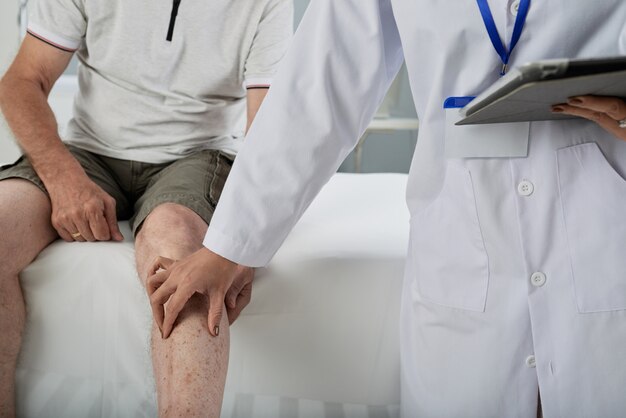
**Understanding Phlebitis: A Simple Guide**
Phlebitis refers to the inflammation of a vein. If the inflammation is caused by one or more blood clots in the vein, it’s called thrombophlebitis. This condition can occur in veins close to the skin’s surface (superficial phlebitis) or deeper veins, particularly in the legs. Deep vein thrombophlebitis is diagnosed when blood clots form in deep veins. Thrombophlebitis can also develop in veins in the arms or legs, where a blood clot (thrombus) may cause pain and block normal blood flow.
Superficial phlebitis usually affects veins near the skin’s surface and is rarely serious. It often resolves quickly. However, in some cases, it may lead to deep vein thrombophlebitis, which is a more serious condition. Deep vein thrombophlebitis can result in pulmonary embolism, where a blood clot travels to the lungs, creating life-threatening complications.
### Recognizing Symptoms
Phlebitis symptoms can vary and may include pain, redness, tenderness, and bulging veins. Some patients might experience a mild fever. For those with septic thrombophlebitis—a more severe infection—symptoms can include high fever and pus drainage. In cases of deep vein thrombosis (DVT), swelling and pain might make walking difficult, and in severe scenarios, symptoms could escalate to shortness of breath or chest pain if a clot travels to the lungs.
### Common Causes of Phlebitis
Superficial phlebitis often doesn’t have a clear cause but can develop after medical treatments like IV insertions or injuries to varicose veins. Causes of deep vein thrombosis include:
– Prolonged inactivity, such as sitting for extended periods or being bedridden
– Paralysis
– Certain cancers
– Hormone replacement therapy (HRT) or estrogen use
– Genetic conditions
– Vein injuries
– Blood clotting disorders
– Issues hindering normal blood flow
### Risk Groups
Certain individuals are more likely to develop phlebitis:
– People who are overweight
– Smokers
– Those with sedentary lifestyles
– Pregnant women
– Individuals using HRT or birth control pills
– Those with a family history of blood clots
– People with leg or arm injuries
Superficial phlebitis may also arise from surgical or medical procedures, especially when veins are injured. Blood clots can occasionally form without any apparent injury, adding to the risk.
### Types of Symptoms
**Superficial Phlebitis:**
This typically presents as redness, warmth, tenderness, and swelling along a vein. The area may feel hard and appear irritated. Sometimes, a thin red stripe can be seen along the inflamed vein, and patients may feel a burning or throbbing sensation.
**Deep Vein Phlebitis (DVT):**
In some cases, symptoms overlap with superficial phlebitis, but there may also be significant pain and swelling extending through the limb. If left untreated, deep vein thrombophlebitis can lead to warm, red, and swollen areas, as well as skin sores or infections in chronic cases. A clot breaking loose and reaching the lungs is particularly dangerous.
### When to Seek Medical Help
If you experience symptoms like swelling, pain, or inflamed veins in your arms or legs, consult a healthcare provider, especially if the condition worsens or persists for over a week. Seek immediate medical assistance if you notice high fever alongside these symptoms, unexplained shortness of breath, or lumps in the limbs, as these could be signs of a clot reaching the lungs.
### Diagnosing Phlebitis
Superficial phlebitis can often be diagnosed through a physical exam. For DVT, more comprehensive tests like ultrasounds, CT scans, MRI scans, or blood tests (like the D-dimer test) are typically needed. These tests help identify clots or blockages in blood flow.
Conditions that mimic phlebitis include cellulitis and lymphangitis, which require different treatment approaches.
### Treating Phlebitis
**Superficial Phlebitis:**
Treatment often involves simple self-care. Warm compresses, elevating the affected area, walking, and taking anti-inflammatory medications like ibuprofen or aspirin can reduce pain and improve blood flow. Compression stockings may also help. If an IV line or catheter caused the issue, it should be removed.
**Deep Vein Phlebitis:**
This requires immediate medical attention. Blood-thinning medications like heparin are commonly prescribed to prevent clot growth. Severe cases may need interventions like clot removal via catheter or surgery, and filters may be placed in the vena cava to stop clots from traveling to the lungs. Recovery can take months for thrombophlebitis.
### Medications for Treatment
– **Anticoagulants (Blood Thinners):** These include medications like heparin, warfarin, or newer options like rivaroxaban to manage DVT.
– **NSAIDs:** Non-steroidal anti-inflammatory drugs reduce inflammation and prevent superficial thrombophlebitis from worsening.
– **Clot-Dissolving Drugs:** For severe conditions, medications like alteplase can dissolve blood clots.
– **Antibiotics:** These are only used if an infection, such as septic thrombophlebitis, is present.
### Surgical Options
In some cases, surgery may be necessary. This could involve removing infected vein segments (excision), handling complications like abscesses, or addressing significant varicose veins through procedures like vein stripping. If the condition extends to deeper veins or other treatments don’t work, surgical intervention might be essential.
### Self-Care Tips
For superficial phlebitis, staying active and avoiding bed rest is crucial since movement improves blood flow. Wearing compression stockings and using warm compresses can help manage symptoms. Avoiding prolonged inactivity and staying hydrated are also effective preventive measures.
### Final Thoughts
While superficial phlebitis is usually harmless and resolves on its own, deeper vein involvement can lead to severe complications. Understanding the symptoms and seeking timely medical care are critical. If you develop signs of deep vein thrombophlebitis or suspect a blood clot has moved towards your lungs, don’t delay in reaching out to a doctor.